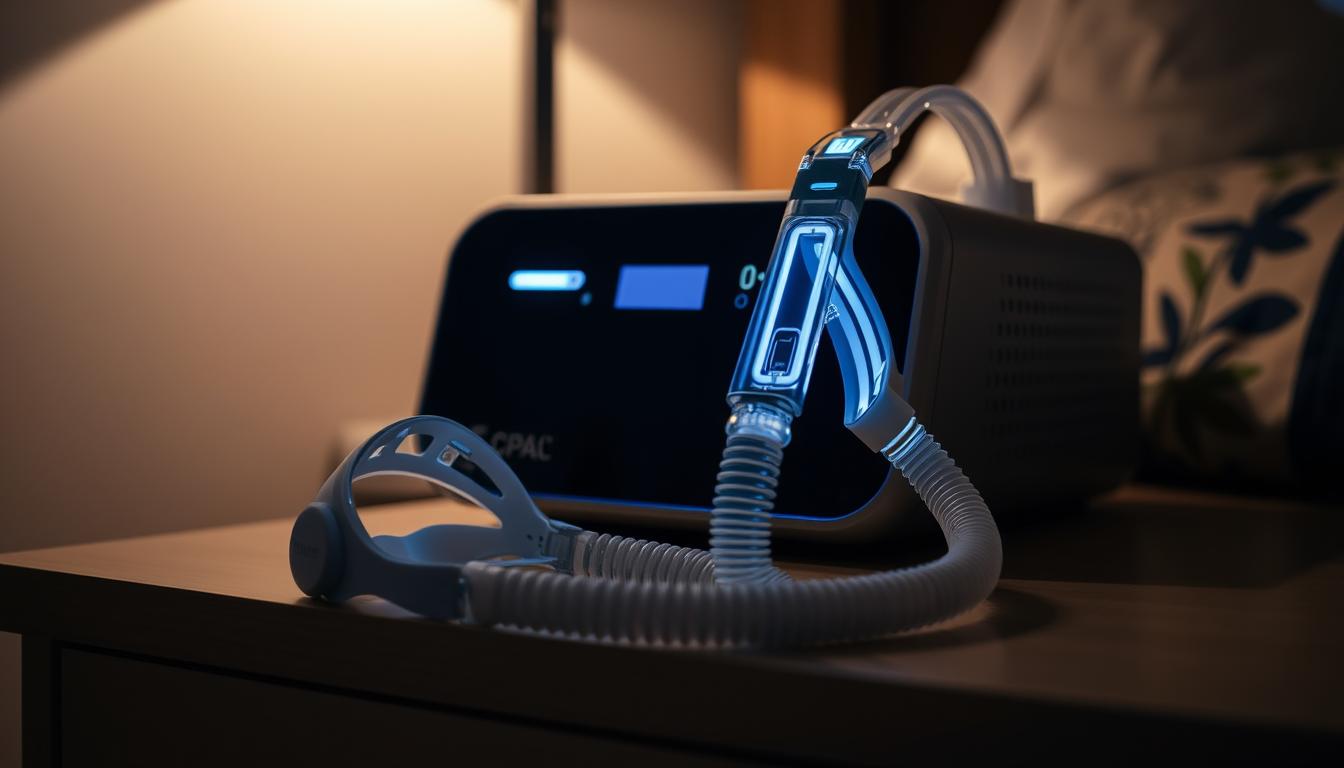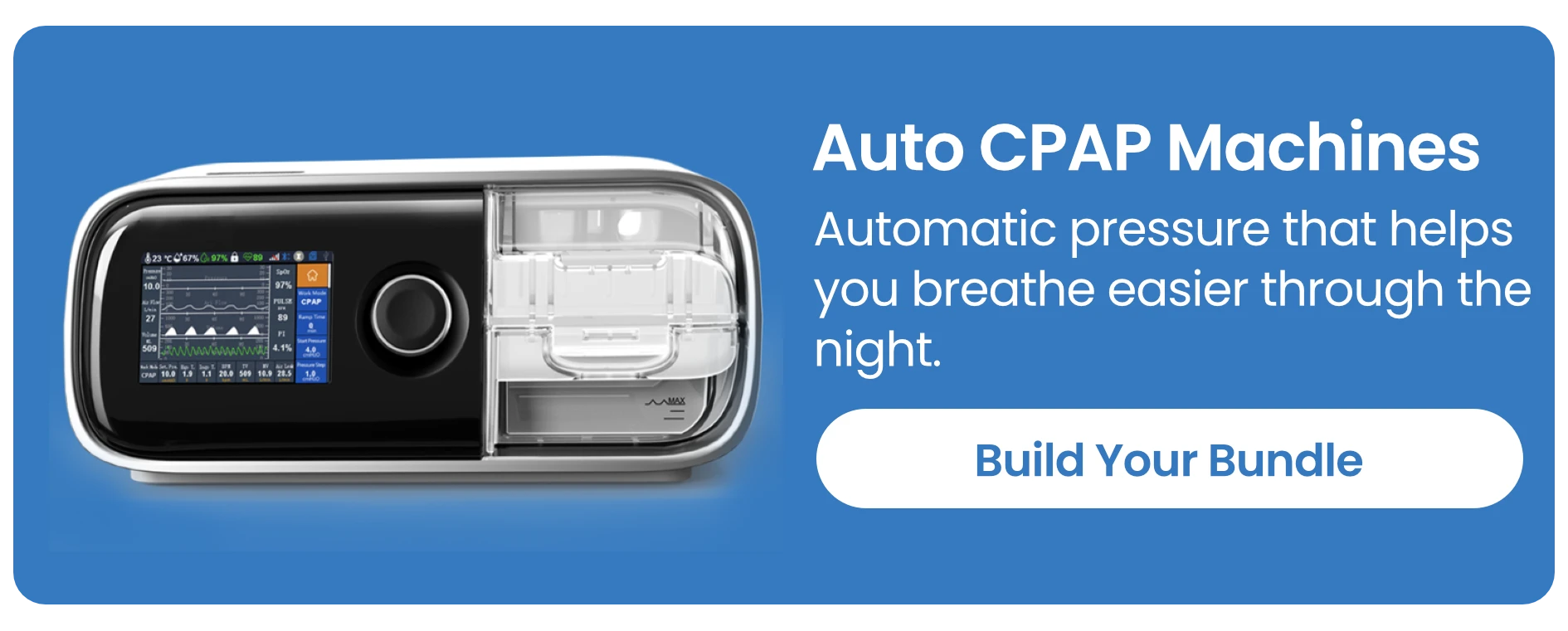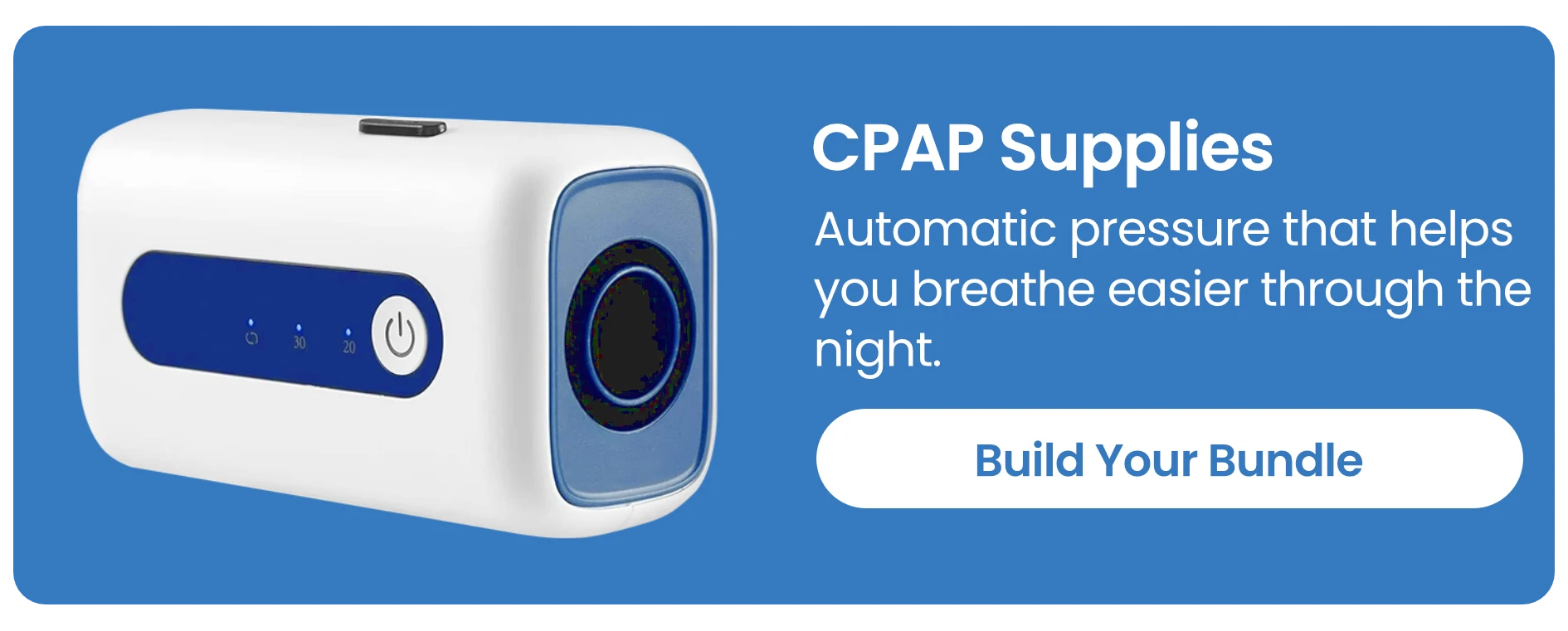Discover the Perfect CPAP Machine for Sleeping

Shopping for a CPAP machine can be a daunting task, but for those suffering from sleep apnea, it’s a crucial step towards better nights and more energized days. Experienced users of CPAP therapy will attest that it’s a game-changer.

Finding the right CPAP machine involves understanding your specific needs and preferences. This article aims to guide you through the process, providing insights into the latest technology and features available in CPAP machines designed for comfortable sleeping.
Key Takeaways
- Understanding the importance of CPAP therapy for sleep apnea treatment
- Key features to look for in a CPAP machine for comfortable sleeping
- Tips for choosing the right CPAP machine based on individual needs
- Overview of the latest CPAP technology and innovations
- How to make the most out of your CPAP therapy experience
Understanding CPAP Therapy and Its Benefits
For individuals with sleep apnea, CPAP therapy can be a game-changer. CPAP, or Continuous Positive Airway Pressure, therapy involves using a machine that delivers a steady stream of pressurized air through a mask into the upper airway, ensuring uninterrupted breathing during sleep.
What is CPAP Therapy?
CPAP therapy is a common treatment for obstructive sleep apnea (OSA). It works by keeping the airway open, preventing the pauses in breathing that characterize sleep apnea. The therapy is administered through a CPAP machine, which is connected to a mask that covers the nose and/or mouth.
How CPAP Machines Improve Sleep Quality
CPAP machines significantly enhance sleep quality by ensuring consistent airflow, thus reducing sleep disruptions. This leads to more restful and rejuvenating sleep. Improved sleep quality can have a profound impact on overall health and well-being.
Health Benefits of Consistent CPAP Use
Consistent use of CPAP therapy can lead to numerous health benefits, including:
| Health Benefit | Description |
|---|---|
| Reduced Daytime Fatigue | Improved sleep quality leads to better daytime functioning. |
| Lower Blood Pressure | Regular CPAP use can help reduce high blood pressure. |
| Improved Cognitive Function | Better sleep enhances concentration and memory. |
By understanding and leveraging CPAP therapy, individuals with sleep apnea can significantly improve their sleep quality and overall health.
Types of CPAP Machines for Sleeping
For individuals suffering from sleep apnea, various types of CPAP machines are available to cater to different needs and preferences. The diversity in CPAP machines ensures that users can find a device that suits their lifestyle and comfort requirements.
Standard CPAP Machines
Standard CPAP machines deliver a continuous flow of pressurized air to keep the airway open during sleep. They are preset to a specific pressure and are suitable for many users with sleep apnea.
Auto-Adjusting CPAP (APAP) Machines
APAP machines automatically adjust the air pressure throughout the night based on the user’s breathing patterns. This feature is beneficial for individuals whose pressure needs vary during sleep.
BiPAP Machines
BiPAP machines provide two different pressures: a higher pressure for inhalation and a lower pressure for exhalation. This can be more comfortable for some users, especially those who require higher pressures.
Travel CPAP Machines
Travel CPAP machines are designed to be compact and lightweight, making them ideal for users who need to continue their CPAP therapy while traveling. Despite their smaller size, they offer similar functionality to standard CPAP machines.
| Type of CPAP Machine | Key Features | Benefits |
|---|---|---|
| Standard CPAP | Continuous flow, preset pressure | Simple, effective for consistent pressure needs |
| APAP | Auto-adjusting pressure | Adapts to changing pressure needs during sleep |
| BiPAP | Dual pressure settings | Easier exhalation, suitable for higher pressure needs |
| Travel CPAP | Compact, lightweight | Portable, convenient for travel |
Understanding the different types of CPAP machines available can help individuals with sleep apnea make informed decisions about their therapy. By choosing the right CPAP machine, users can improve their sleep quality and overall health.
Key Features to Consider When Choosing a CPAP Machine
Choosing the right CPAP machine can be a daunting task, but understanding its key features can simplify the process. With various models available, each with unique features, it’s essential to know what to look for to ensure effective therapy.
Pressure Range and Adjustability
The pressure range and adjustability of a CPAP machine are critical for comfortable therapy. Machines with a wide pressure range can accommodate different user needs, and auto-adjusting models can adapt to changes in pressure requirements throughout the night.
Noise Level and Operating Sound
A quiet CPAP machine is vital for both the user and their partner. Look for machines with low decibel ratings or those designed to operate silently.
Humidification Options and Benefits
Humidification is a crucial feature that helps prevent dryness and discomfort. Some machines come with built-in humidifiers, and some offer heated humidification for added comfort.
Size, Weight, and Portability Factors
For travelers, the size and weight of a CPAP machine are significant considerations. Compact and lightweight models are easier to transport.
Data Tracking and Smart Features
Modern CPAP machines often include data tracking and smart features, such as compliance monitoring and therapy data analysis, which can be invaluable for managing therapy effectively.
Top CPAP Machines for Sleeping in 2023
In 2023, the most effective CPAP machines for sleeping have been identified through rigorous testing and patient feedback. Our team of respiratory therapists has evaluated dozens of devices, carefully analyzing their operation, features, and patient feedback to make your shopping process as efficient as possible.
ResMed AirSense 11 AutoSet
The ResMed AirSense 11 AutoSet is a top-rated CPAP machine known for its advanced features and comfort. It includes an integrated humidifier and is designed for ease of use.
Philips Respironics DreamStation 2
The Philips Respironics DreamStation 2 is another highly-regarded CPAP machine. It features a modular design, allowing users to customize their therapy. Its compact size and quiet operation make it a popular choice.
ResMed AirMini Travel CPAP
For those who travel frequently, the ResMed AirMini Travel CPAP is an excellent option. It’s compact, lightweight, and designed for portability without compromising on performance.
Fisher & Paykel SleepStyle Auto
The Fisher & Paykel SleepStyle Auto offers advanced auto-adjusting technology and a range of comfort features, including a built-in humidifier. It’s designed to provide effective therapy while enhancing user comfort.
Here’s a comparison of these top CPAP machines:
| CPAP Machine | Key Features | Dimensions | Noise Level |
|---|---|---|---|
| ResMed AirSense 11 AutoSet | Integrated humidifier, auto-adjusting pressure | 11.4 x 7.7 x 5.9 inches | 26 dB |
| Philips Respironics DreamStation 2 | Modular design, customizable therapy | 7.8 x 5.9 x 4.4 inches | 25 dB |
| ResMed AirMini Travel CPAP | Compact, lightweight, portable | 5.9 x 3.3 x 2.8 inches | 28 dB |
| Fisher & Paykel SleepStyle Auto | Auto-adjusting pressure, built-in humidifier | 10.2 x 7.4 x 5.5 inches | 26 dB |
When choosing a CPAP machine, consider factors such as pressure range, noise level, and additional features like humidification and data tracking. These top models in 2023 offer a range of benefits to suit different needs and preferences.
Comparing Leading CPAP Machine Brands
When it comes to CPAP machines, several brands stand out for their quality and innovation. The choice of brand can significantly impact the effectiveness of the treatment and the comfort of the user.
ResMed vs. Philips Respironics
ResMed and Philips Respironics are two of the most recognized names in the CPAP industry. ResMed is known for its advanced technology and user-friendly designs, while Philips Respironics offers a wide range of models with various features. ResMed’s AirSense series is praised for its comfort and ease of use, whereas Philips Respironics’ DreamStation series is noted for its smart features and connectivity options.
Fisher & Paykel vs. DeVilbiss
Fisher & Paykel and DeVilbiss are also prominent players. Fisher & Paykel is recognized for its innovative humidification systems and comfortable masks. DeVilbiss, on the other hand, offers a range of CPAP machines with advanced features at competitive prices. Fisher & Paykel’s SleepStyle series is particularly popular for its ease of use and comfort.
Budget Brands Worth Considering
For those on a budget, brands like 3B Medical and CareFusion offer affordable options without compromising on essential features.
Warranty and Customer Support Comparison
When choosing a CPAP machine, it’s crucial to consider the warranty and customer support offered by the manufacturer. Brands like ResMed and Philips Respironics typically offer comprehensive warranties and dedicated customer support.
“A good warranty can provide peace of mind and protect your investment,” says a CPAP expert.
Ultimately, the best brand for you will depend on your specific needs, preferences, and budget. It’s essential to research and compare different models and brands before making a decision.
Best CPAP Machines for Different Sleep Positions
Sleep position plays a crucial role in selecting the most comfortable and effective CPAP machine. Different sleep positions require tailored features to ensure optimal therapy and comfort.
Optimal Machines for Side Sleepers
Side sleepers often benefit from CPAP machines with flexible mask options and adjustable headgear to accommodate their sleep position. The ResMed AirSense 11 AutoSet is a popular choice among side sleepers due to its comfort and adaptability.
According to a study, “The use of CPAP therapy has been shown to improve sleep quality in patients with obstructive sleep apnea, regardless of sleep position” (
Somers et al., 2008
).
Recommended Options for Back Sleepers
Back sleepers can use a variety of CPAP machines, but those with advanced features like auto-adjusting pressure are particularly beneficial. The Philips Respironics DreamStation 2 is highly recommended for its advanced features and comfort.
Solutions for Stomach Sleepers
Stomach sleepers often prefer CPAP machines that are compact and have a low profile to minimize discomfort. The ResMed AirMini Travel CPAP is a great option due to its small size and quiet operation.
Versatile Machines for Combination Sleepers
For those who switch between different sleep positions, a CPAP machine that adapts to their needs is essential. The Fisher & Paykel SleepStyle Auto is versatile and can adjust to various sleep positions, making it ideal for combination sleepers.
| Sleep Position | Recommended CPAP Machine | Key Features |
|---|---|---|
| Side Sleepers | ResMed AirSense 11 AutoSet | Flexible mask options, adjustable headgear |
| Back Sleepers | Philips Respironics DreamStation 2 | Auto-adjusting pressure, advanced features |
| Stomach Sleepers | ResMed AirMini Travel CPAP | Compact, low profile, quiet operation |
| Combination Sleepers | Fisher & Paykel SleepStyle Auto | Adaptable to various sleep positions |

Everyone has different needs, preferences, and face shapes, so it may be necessary to try different mask styles before finding one that works best for you.
CPAP Machine for Sleeping: Comfort Enhancements and Accessories
To maximize the benefits of CPAP therapy, comfort enhancements and accessories are essential. These additions can significantly improve the overall CPAP experience, making it more comfortable and effective.
Finding Your Perfect Mask Type
Choosing the right mask is crucial for CPAP comfort. There are various mask types available, including nasal masks, full-face masks, and nasal pillows. Proper sizing is important because the right fit adds to comfort and performance.
Heated Tubing and Comfort Hoses
Heated tubing is another comfort enhancement that can improve the CPAP experience. It helps to reduce condensation and prevents dryness in the nasal passages, making therapy more comfortable.
CPAP Pillows and Positional Aids
CPAP pillows are designed to help users maintain a comfortable position while sleeping with their CPAP mask on. These pillows can reduce pressure on the mask and improve overall sleep quality.
Essential Cleaning Supplies and Tools
Regular cleaning is vital for maintaining the effectiveness of CPAP therapy. Essential cleaning supplies include mask wipes, tubing cleaners, and humidifier cleaning solutions.
| Accessory | Description | Benefits |
|---|---|---|
| Heated Tubing | Heats the air delivered through the CPAP machine | Reduces condensation, prevents dryness |
| CPAP Pillows | Specially designed pillows for CPAP users | Improves comfort, reduces mask pressure |
| Mask Wipes | Gentle cleaning wipes for CPAP masks | Maintains hygiene, extends mask life |
Adapting to Your New CPAP Machine
The journey to comfortable CPAP use begins with understanding how to adapt to your new machine effectively. As Diane Salazar, BS, RRT, Sleep Care Manager at Sleep Doctor, suggests, “When selecting a CPAP machine, you should consider what’s most important to you.” This advice is crucial not only for choosing the right machine but also for adapting to its use.
First Week Tips for New Users
During the first week, it’s essential to start slowly. Begin by wearing your CPAP mask for a few hours while you’re awake to get used to the feeling. Then, gradually increase the duration as you become more comfortable.
Overcoming Common Adjustment Challenges
Common challenges include mask discomfort and claustrophobia. Using a mask liner or adjusting the straps can help alleviate these issues.
| Challenge | Solution |
|---|---|
| Mask Discomfort | Adjust straps or use a mask liner |
| Claustrophobia | Start with short sessions, gradually increase time |
Gradually Increasing Usage Time
Begin with a few hours per night and gradually increase to a full night’s sleep. Consistency is key to successful adaptation.
When to Consult Your Sleep Specialist
If you experience persistent discomfort or difficulty adjusting, consult your sleep specialist for personalized guidance.
Setting Up Your CPAP Machine for Optimal Sleep
Effective CPAP machine setup is key to improving your sleep and overall health. A well-configured CPAP machine can significantly enhance the quality of your sleep, leading to better rest and recovery.
Step-by-Step Initial Setup Guide
To set up your CPAP machine, follow these steps:
- Carefully unpack and inspect your CPAP machine and accessories.
- Read the user manual to understand the machine’s features and settings.
- Assemble the machine according to the manufacturer’s instructions.
- Plug in the machine and turn it on to test its functionality.
Adjusting Pressure Settings Safely
Adjusting the pressure settings on your CPAP machine is crucial for effective therapy. Start with the prescribed pressure setting and gradually adjust as needed, in consultation with your healthcare provider. It’s essential to monitor your sleep patterns and adjust the pressure accordingly to ensure optimal comfort and therapy.

Optimizing Humidification Levels
Humidification is a critical aspect of CPAP therapy, as it helps prevent dryness and discomfort in the nasal passages. Adjust the humidification level based on your comfort and the climate you live in. Some CPAP machines come with automatic humidification adjustment, while others require manual setting.
Creating a Sleep-Friendly Environment
Creating a sleep-friendly environment is vital for the success of CPAP therapy. Ensure your bedroom is dark, quiet, and at a comfortable temperature. Consider using earplugs, a white noise machine, or blackout curtains if necessary. A comfortable sleep environment, combined with proper CPAP setup, can significantly improve your sleep quality.
Troubleshooting Common CPAP Machine Issues
To get the most out of your CPAP machine, it’s essential to know how to troubleshoot common problems. Despite their effectiveness in managing sleep apnea, CPAP machines can sometimes cause discomfort or malfunction. Understanding how to address these issues can significantly improve your therapy experience.
Resolving Mask Leaks and Fit Problems
Mask leaks are a common issue with CPAP therapy. To minimize leaks, ensure your mask is properly fitted. Adjusting the straps and using a mask liner can help create a tighter seal. If leaks persist, consider trying a different mask type or size.
Managing Pressure Discomfort
Some users experience discomfort due to the pressure settings of their CPAP machine. If the pressure feels too high, consult your healthcare provider about potentially adjusting the settings. Using an auto-adjusting CPAP machine can also help, as it adjusts pressure levels throughout the night.
Addressing Dry Mouth and Nasal Congestion
Dry mouth and nasal congestion are common side effects of CPAP therapy. Using a heated humidifier can help alleviate these issues by adding moisture to the air. Ensure the humidifier is cleaned regularly to prevent bacterial growth.
Reducing Machine Noise and Disturbances
Some CPAP machines can be noisy, potentially disturbing sleep. Look for machines with noise-reducing features or consider using a white noise machine to mask the sound. Regular maintenance, such as cleaning or replacing filters, can also help reduce noise levels.
Maintaining Your CPAP Machine for Longevity
Proper maintenance of your CPAP machine is crucial for its longevity and effectiveness. Regular cleaning and maintenance not only ensure the device functions correctly but also contribute to the user’s health and comfort.
Daily and Weekly Cleaning Routines
Daily cleaning involves wiping down the mask and washing the humidifier chamber. Weekly, you should clean the tubing and inspect the filter. Using the right cleaning materials is essential, as they are considered vital CPAP accessories.
Monthly Maintenance Checklist
A monthly check involves inspecting the mask for wear, cleaning or replacing the filter as needed, and checking the humidifier for mineral buildup. This routine helps prevent bacterial growth and ensures the machine operates smoothly.
| Maintenance Task | Frequency |
|---|---|
| Clean Mask | Daily |
| Inspect and Clean Tubing | Weekly |
| Replace Filter | Monthly |
Replacement Schedule for Parts
Parts such as filters, masks, and tubing have recommended replacement schedules. Typically, filters should be replaced every 1-3 months, masks every 3-6 months, and tubing every 6-12 months.
Professional Servicing Guidelines
While much of the maintenance can be done by the user, professional servicing is recommended annually to ensure the CPAP machine is functioning correctly and to address any technical issues.
Conclusion
Using a CPAP machine for sleeping can significantly improve the quality of life for individuals with sleep apnea. By providing a consistent flow of air pressure into the airways, CPAP machines help prevent the pauses in breathing that characterize sleep apnea.
As discussed, various types of CPAP machines are available, including standard, auto-adjusting, and BiPAP machines. Choosing the right CPAP machine involves considering factors such as pressure range, noise level, and humidification options.
By selecting the appropriate CPAP machine and following proper usage and maintenance guidelines, individuals with sleep apnea can experience improved sleep quality and overall health benefits. Consistent use of a CPAP machine can lead to more restorative rest and a better quality of life.
FAQ
What is a CPAP machine, and how does it work?
A CPAP (Continuous Positive Airway Pressure) machine is a device used to treat sleep apnea by delivering a steady stream of pressurized air through a mask that covers the nose and/or mouth, keeping the airway open during sleep.
What are the benefits of using a CPAP machine for sleeping?
Using a CPAP machine can improve sleep quality, reduce symptoms of sleep apnea, and lower the risk of related health problems, such as high blood pressure, heart disease, and diabetes.
How do I choose the right CPAP machine for my needs?
When choosing a CPAP machine, consider factors such as pressure range, noise level, humidification options, size, and data tracking features, as well as your specific sleep position and comfort preferences.
What is the difference between a standard CPAP machine and an APAP machine?
A standard CPAP machine delivers a fixed pressure setting, while an APAP (Auto-Adjusting CPAP) machine automatically adjusts the pressure throughout the night to ensure optimal comfort and therapy.
How often should I clean and maintain my CPAP machine?
It’s recommended to clean your CPAP machine daily, with a more thorough cleaning weekly, and to perform routine maintenance tasks, such as replacing filters and checking for worn-out parts, to ensure optimal performance and hygiene.
Can I travel with my CPAP machine?
Yes, many CPAP machines are designed to be portable and travel-friendly, with features such as compact size, battery operation, and universal power adapters, making it easy to take your machine on the go.
How can I troubleshoot common issues with my CPAP machine?
Common issues, such as mask leaks, pressure discomfort, and machine noise, can often be resolved by adjusting the mask fit, pressure settings, or humidification levels, or by consulting your sleep specialist or manufacturer’s guidelines.
Are there any comfort enhancements or accessories that can improve my CPAP experience?
Yes, various comfort enhancements and accessories, such as heated tubing, CPAP pillows, and nasal saline sprays, can help improve comfort and therapy effectiveness, and can be tailored to your specific needs and preferences.
















